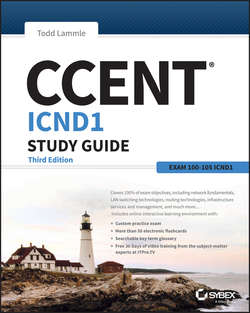CCENT ICND1 Study Guide

Реклама. ООО «ЛитРес», ИНН: 7719571260.
Оглавление
Lammle Todd. CCENT ICND1 Study Guide
Acknowledgments
About the Author
Introduction
Cisco’s Network Certifications
What Does This Book Cover?
Interactive Online Learning Environment and Test Bank
How to Use This Book
Where Do You Take the Exams?
ICND1 (100-105) Exam Objectives
Assessment Test
Answers to Assessment Test
Chapter 1. Internetworking
Internetworking Basics
Internetworking Models
The OSI Reference Model
Summary
Exam Essentials
Written Labs
Review Questions
Chapter 2. Ethernet Networking and Data Encapsulation
Ethernet Networks in Review
Ethernet Cabling
Data Encapsulation
The Cisco Three-Layer Hierarchical Model
Summary
Exam Essentials
Written Labs
Review Questions
Chapter 3. Introduction to TCP/IP
Introducing TCP/IP
TCP/IP and the DoD Model
IP Addressing
IPv4 Address Types
Summary
Exam Essentials
Written Labs
Review Questions
Chapter 4. Easy Subnetting
Subnetting Basics
Summary
Exam Essentials
Written Labs
Review Questions
Chapter 5. VLSMs, Summarization, and Troubleshooting TCP/IP
Variable Length Subnet Masks (VLSMs)
Summarization
Troubleshooting IP Addressing
Summary
Exam Essentials
Written Lab 5
Review Questions
Chapter 6. Cisco’s Internetworking Operating System (IOS)
The IOS User Interface
Command-Line Interface (CLI)
Administrative Configurations
Router and Switch Interfaces
Viewing, Saving, and Erasing Configurations
Summary
Exam Essentials
Written Lab 6: IOS Understanding
Hands-on Labs
Review Questions
Chapter 7. Managing a Cisco Internetwork
The Internal Components of a Cisco Router and Switch
Backing Up and Restoring the Cisco Configuration
Configuring DHCP
Syslog
Network Time Protocol (NTP)
Exploring Connected Devices Using CDP and LLDP
Using Telnet
Resolving Hostnames
Checking Network Connectivity and Troubleshooting
Summary
Exam Essentials
Written Labs 7
Hands-on Labs
Review Questions
Chapter 8. Managing Cisco Devices
Managing the Configuration Register
Backing Up and Restoring the Cisco IOS
Summary
Exam Essentials
Written Lab 8
Hands-on Labs
Review Questions
Chapter 9. IP Routing
Routing Basics
The IP Routing Process
Configuring IP Routing
Configuring IP Routing in Our Network
Dynamic Routing
Routing Information Protocol (RIP)
Summary
Exam Essentials
Written Lab 9
Hands-on Labs
Review Questions
Chapter 10. Layer 2 Switching
Switching Services
Configuring Catalyst Switches
Summary
Exam Essentials
Written Lab 10
Hands-on Labs
Review Questions
Chapter 11. VLANs and Inter-VLAN Routing
VLAN Basics
Identifying VLANs
Routing between VLANs
Configuring VLANs
Summary
Exam Essentials
Written Lab 11
Hands-on Labs
Review Questions
Chapter 12. Security
Perimeter, Firewall, and Internal Routers
Introduction to Access Lists
Standard Access Lists
Extended Access Lists
Monitoring Access Lists
Summary
Exam Essentials
Written Lab 12
Hands-on Labs
Review Questions
Chapter 13. Network Address Translation (NAT)
When Do We Use NAT?
Types of Network Address Translation
NAT Names
How NAT Works
Testing and Troubleshooting NAT
Summary
Exam Essentials
Written Lab 13
Hands-on Labs
Review Questions
Chapter 14. Internet Protocol Version 6 (IPv6)
Why Do We Need IPv6?
The Benefits and Uses of IPv6
IPv6 Addressing and Expressions
How IPv6 Works in an Internetwork
IPv6 Routing Protocols
Configuring IPv6 on Our Internetwork
Configuring Routing on Our Internetwork
Summary
Exam Essentials
Written Labs 14
Hands-on Labs
Review Questions
Appendix A. Answers to Written Labs
Chapter 1: Internetworking
Chapter 2: Ethernet Networking and Data Encapsulation
Chapter 3: Introduction to TCP/IP
Chapter 4: Easy Subnetting
Chapter 5: VLSMs, Summarization and Troubleshooting TCP/IP
Chapter 6: Cisco’s Internetworking Operating System (IOS)
Chapter 7: Managing a Cisco Internetwork
Chapter 8: Managing Cisco Devices
Chapter 9: IP Routing
Chapter 10: Layer 2 Switching
Chapter 11: VLANs and InterVLAN Routing
Chapter 12: Security
Chapter 13: Network Address Translation (NAT)
Chapter 14: Internet Protocol Version 6 (IPv6)
Written Lab 14.2: EUI-64 Format
Appendix B. Answers to Review Questions
Chapter 1: Internetworking
Chapter 2: Ethernet Networking and Data Encapsulation
Chapter 3: Introduction to TCP/IP
Chapter 4: Easy Subnetting
Chapter 5: VLSMs, Summarization, and Troubleshooting TCP/IP
Chapter 6: Cisco's Internetworking Operating System (IOS)
Chapter 7: Managing a Cisco Internetwork
Chapter 8: Managing Cisco Devices
Chapter 9: IP Routing
Chapter 10: Layer 2 Switching
Chapter 11: VLANs and InterVLAN Routing
Chapter 12: Security
Chapter 13: Network Address Translation (NAT)
Chapter 14: Internet Protocol Version 6 (IPv6)
Appendix C. Disabling and Configuring Network Services
Blocking SNMP Packets
Disabling Echo
Turning off BootP and Auto-Config
Disabling the HTTP Interface
Disabling IP Source Routing
Disabling Proxy ARP
Disabling Redirect Messages
Disabling the Generation of ICMP Unreachable Messages
Disabling Multicast Route Caching
Disabling the Maintenance Operation Protocol (MOP)
Turning Off the X.25 PAD Service
Enabling the Nagle TCP Congestion Algorithm
Logging Every Event
Disabling Cisco Discovery Protocol
Disabling the Default Forwarded UDP Protocols
Cisco’s auto secure
WILEY END USER LICENSE AGREEMENT
Отрывок из книги
There are many people that work to put a book together, and as an author, I dedicated an enormous amount of time to write this book, but it would have never been published without the dedicated, hard work of many other people.
Kenyon Brown, my acquisitions editor, is instrumental to my success in the world of Cisco certification. Ken, I look forward to our continued progress together in both the print and video markets!
.....
Chapter 4: Easy Subnetting You’ll actually be able to subnet a network in your head after reading this chapter if you really want to! And you’ll find plenty of help in this chapter as long as you don’t skip the written labs and review questions at the end.
Chapter 5: VLSMs, Summarization, and Troubleshooting TCP/IP Here, you’ll find out all about variable length subnet masks (VLSMs) and how to design a network using VLSMs. This chapter will finish with summarization techniques and configurations. As with Chapter 4, plenty of help is there for you if you don’t skip the written lab and review questions.
.....